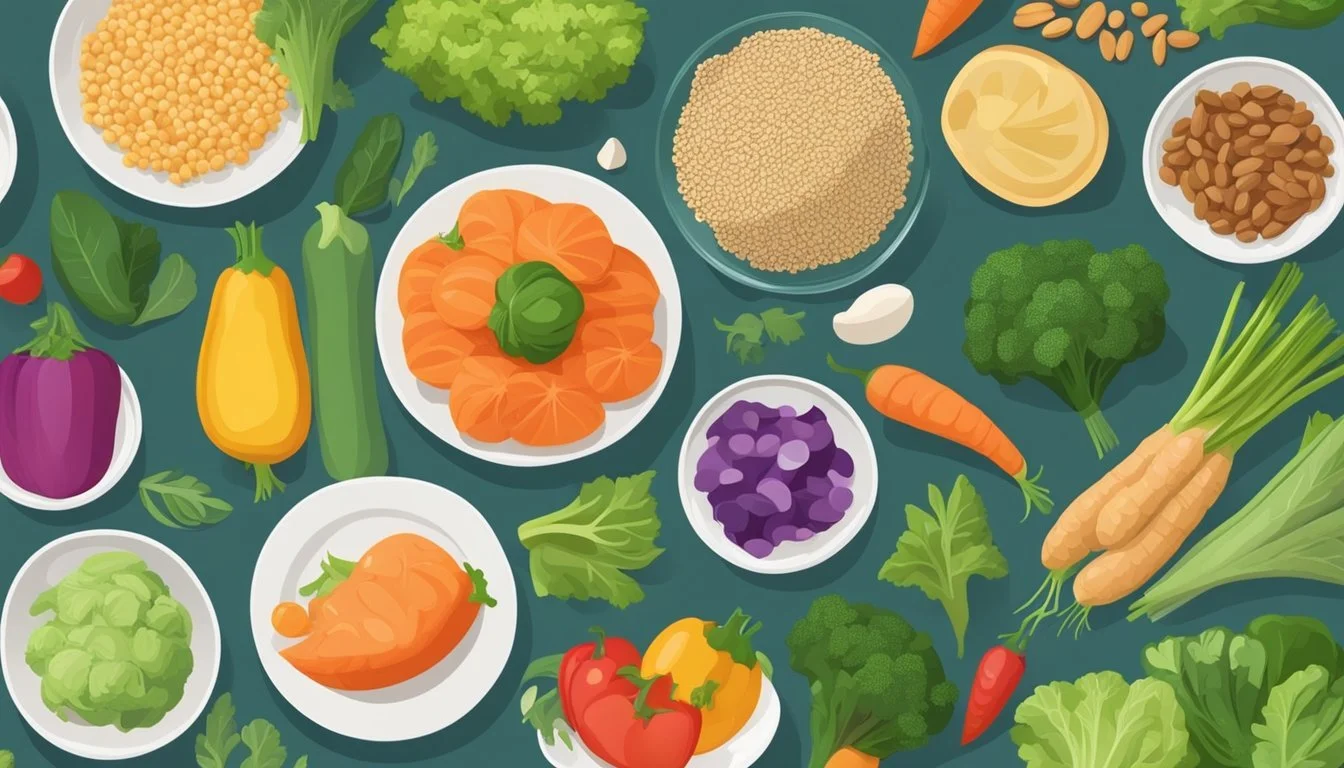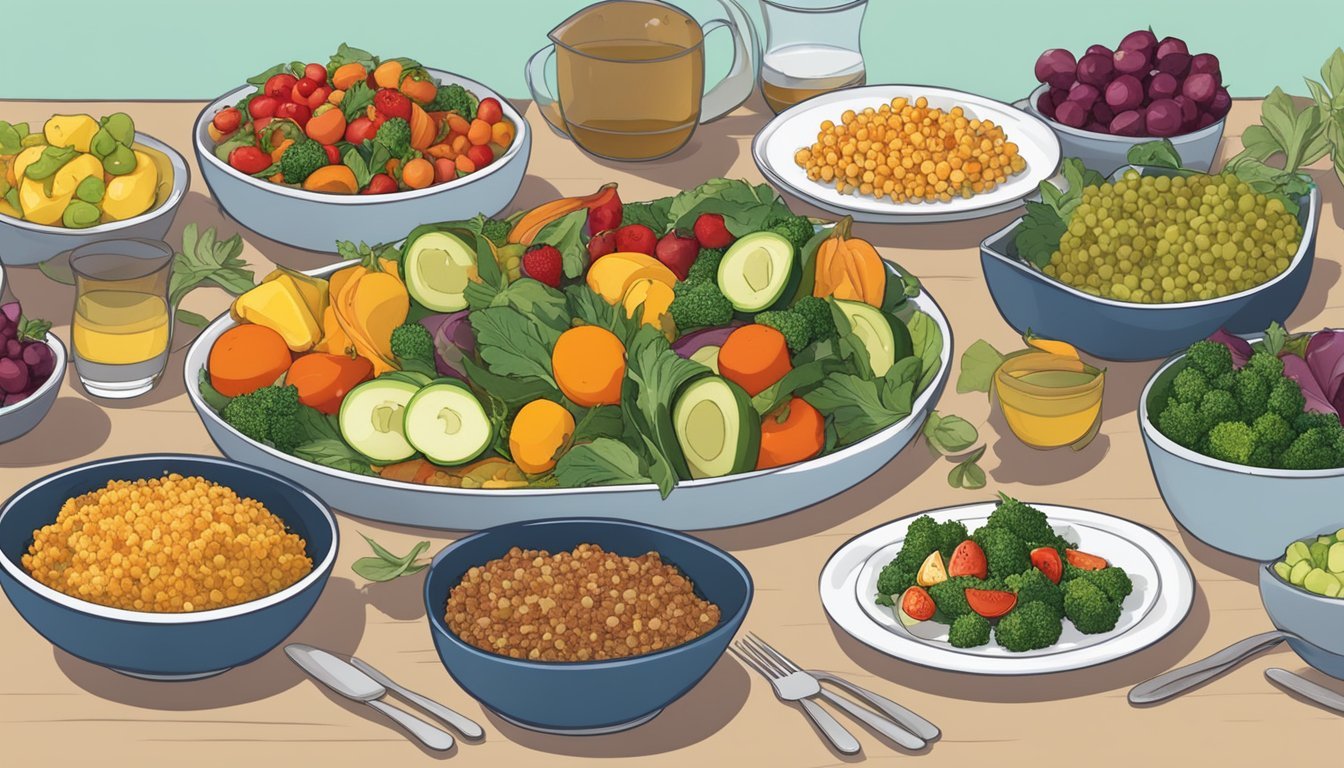Hosting a Delicious Diabetes-Friendly Dinner Party: Crowd-Pleasing Recipes and Tips
Hosting a dinner party while managing diabetes doesn't mean sacrificing flavor or fun. With thoughtful planning and creative recipes, it's possible to serve delicious meals that everyone will enjoy. Diabetes-friendly dinners can be just as satisfying and tasty as traditional fare, focusing on nutritious ingredients and balanced portions.
Many diabetes-friendly recipes incorporate lean proteins, whole grains, and plenty of vegetables. These dishes often feature complex carbohydrates, which help maintain stable blood sugar levels. Popular options include sheet-pan meals with roasted chicken and vegetables, hearty salads, and flavorful fish dishes.
When planning a diabetes-friendly dinner party, consider offering a variety of options to accommodate different tastes and dietary needs. This approach ensures all guests feel included and can enjoy the meal without concern. By prioritizing fresh, whole foods and limiting added sugars and refined carbohydrates, hosts can create a memorable dining experience that supports a healthy eating plan for everyone at the table.
Understanding a Diabetic-Friendly Diet
A diabetic-friendly diet focuses on controlling blood sugar levels through balanced nutrition. It emphasizes portion control, nutrient-dense foods, and strategic meal timing to maintain stable glucose levels throughout the day.
Fundamentals of a Diabetic Diet
A diabetic diet prioritizes consistent carbohydrate intake and balanced meals. It limits simple sugars and refined carbs while promoting whole grains, lean proteins, and healthy fats. Portion control is key to managing blood sugar spikes. Diabetics should aim for regular meal times and avoid skipping meals.
Carbohydrate counting helps track intake and adjust insulin dosages. A typical plan includes 45-60 grams of carbs per meal for women and 60-75 grams for men. Vegetables, fruits, whole grains, and legumes are preferred carb sources.
Monitoring glycemic index (GI) of foods can help choose options that have less impact on blood sugar. Low-GI foods like oats, sweet potatoes, and most non-starchy vegetables are beneficial.
Balancing Macronutrients for Blood Sugar Control
Balancing carbohydrates, proteins, and fats is crucial for blood sugar management. Carbs have the most direct effect on glucose levels, but proteins and fats play important roles too.
Aim for 45-65% of calories from carbs, 15-20% from protein, and 20-35% from fat. This balance helps slow digestion and absorption of glucose, preventing rapid blood sugar spikes.
Pairing carbs with proteins or healthy fats can further stabilize blood sugar. For example, eating an apple with peanut butter or adding nuts to oatmeal.
Lean proteins like chicken, fish, tofu, and legumes are excellent choices. They help maintain muscle mass and provide satiety without impacting blood sugar significantly.
The Importance of Fiber and Whole Grains
Fiber is a crucial component of a diabetic-friendly diet. It slows digestion, improves blood sugar control, and promotes feelings of fullness. Aim for 25-30 grams of fiber daily.
Soluble fiber, found in oats, beans, and fruits, is particularly beneficial. It forms a gel-like substance in the digestive tract, slowing glucose absorption.
Whole grains are rich in fiber and nutrients. They have a lower glycemic impact compared to refined grains. Options include:
Brown rice
Quinoa
Whole wheat bread
Barley
Bulgur
These complex carbohydrates provide sustained energy and help maintain stable blood sugar levels.
Incorporating Healthy Fats into Meals
Healthy fats are an essential part of a diabetic-friendly diet. They slow digestion, improve insulin sensitivity, and provide important nutrients.
Focus on monounsaturated and polyunsaturated fats. Good sources include:
Avocados
Nuts and seeds
Olive oil
Fatty fish (salmon, mackerel, sardines)
These fats can help reduce inflammation and improve heart health, which is important for diabetics who have an increased risk of cardiovascular disease.
Limit saturated and trans fats, found in red meat, full-fat dairy, and processed foods. These can increase insulin resistance and worsen blood sugar control.
Include small amounts of healthy fats with meals to help slow carbohydrate absorption and promote satiety. This can aid in weight management and blood sugar control.
Choosing the Right Ingredients
Selecting diabetes-friendly ingredients is crucial for creating delicious and healthy meals. Focus on low-carb vegetables, lean proteins, and smart substitutes for high-carb foods to keep blood sugar levels stable.
Selecting Low-Carb Vegetables
Non-starchy vegetables are excellent choices for diabetics. Leafy greens like spinach, kale, and lettuce are nutrient-dense and low in carbohydrates. Broccoli, cauliflower, and bell peppers are versatile options that can be used in various dishes.
Zucchini is particularly useful as a pasta substitute. Spiralized zucchini noodles provide a low-carb alternative to traditional spaghetti. Cauliflower can be riced or mashed as a replacement for higher-carb grains or potatoes.
Asparagus, green beans, and Brussels sprouts are other flavorful options that add variety to meals without significantly impacting blood sugar levels.
Protein Choices for Diabetics
Lean proteins are essential for maintaining stable blood sugar levels. Chicken breast is a popular choice due to its versatility and low fat content. Skinless turkey, fish, and lean cuts of beef are also excellent options.
Plant-based proteins like tofu, tempeh, and legumes can be incorporated into meals for added variety. These options provide fiber along with protein, which helps slow digestion and prevent blood sugar spikes.
Eggs are a nutritious and versatile protein source. They can be prepared in numerous ways and are suitable for breakfast, lunch, or dinner dishes.
Smart Swaps for High-Carb Ingredients
Replacing high-carb ingredients with lower-carb alternatives is key to diabetes-friendly cooking. Cauliflower rice is an excellent substitute for regular rice. It can be seasoned and used in stir-fries, casseroles, or as a side dish.
Almond flour or coconut flour can replace wheat flour in many recipes. These alternatives are lower in carbohydrates and higher in fiber and healthy fats.
Greek yogurt can substitute for sour cream in dips and sauces. It provides protein and probiotics while reducing the overall carbohydrate content of the dish.
Lettuce wraps offer a crisp, low-carb alternative to bread or tortillas for sandwiches and tacos. This simple swap significantly reduces the meal's carbohydrate content.
Appetizers and Salads
Diabetes-friendly appetizers and salads offer delicious ways to start a dinner party without spiking blood sugar. These options focus on fresh vegetables, lean proteins, and healthy fats to keep guests satisfied while maintaining balanced nutrition.
Fresh Vegetable Starters
Veggie platters with hummus or Greek yogurt dip provide a colorful and nutritious appetizer. Cherry tomatoes, cucumber slices, and bell pepper strips offer crunch and vitamins. Grilled vegetable skewers with zucchini, mushrooms, and cherry tomatoes make a tasty, low-carb option.
Stuffed mushrooms filled with spinach and feta cheese are both flavorful and diabetes-friendly. Mini caprese skewers with cherry tomatoes, fresh mozzarella, and basil drizzled with balsamic glaze offer a bite-sized Italian treat.
For a warm option, consider roasted Brussels sprouts with a sprinkle of parmesan cheese. These savory bites are packed with fiber and nutrients.
Leafy Greens and Flavorful Salad Options
Salads featuring baby spinach or mixed greens provide essential nutrients while being low in calories. A simple vinaigrette made with olive oil and lemon juice complements the greens without adding excess sugar.
Greek salad with cucumbers, tomatoes, olives, and feta cheese offers a Mediterranean flair. For added protein, top with grilled chicken or shrimp. A spinach and strawberry salad with toasted almonds provides a perfect balance of sweet and savory flavors.
Kale and quinoa salad with roasted vegetables makes a hearty option. The combination of leafy greens and protein-rich quinoa helps stabilize blood sugar levels.
Consider a broccoli slaw with a light yogurt-based dressing for a crunchy, refreshing salad alternative. This fiber-rich option aids in digestion and blood sugar control.
Main Course Options
Crafting diabetes-friendly main courses for a dinner party requires thoughtful ingredient selection and preparation methods. These options balance flavor and nutrition while keeping blood sugar in check.
Poultry-Based Dishes
Chicken and turkey offer lean protein choices ideal for diabetic diets. Grilled lemon herb chicken breasts provide a zesty, low-carb option. Pair with roasted vegetables for a complete meal.
Turkey meatballs made with almond flour instead of breadcrumbs reduce carbohydrate content. Serve with zucchini noodles and a light tomato sauce for a satisfying Italian-inspired dish.
Roasted turkey breast with a sage and garlic rub offers a festive centerpiece. Accompany with mashed cauliflower and green beans for a traditional feel without excess starch.
Seafood Selections for Diabetics
Seafood provides heart-healthy omega-3 fatty acids and high-quality protein. Baked tilapia with a lemon butter sauce and herbs makes an elegant yet simple main course.
Grilled salmon with a sugar-free glaze of mustard and dill pairs well with roasted asparagus. This combination delivers flavor without spiking blood sugar.
Shrimp skewers marinated in garlic and olive oil offer a low-carb option. Serve alongside a mixed green salad with vinaigrette dressing for a light meal.
Vegetarian and Plant-Based Varieties
Plant-based main courses can be both diabetes-friendly and satisfying. Stuffed bell peppers filled with a mixture of quinoa, black beans, and vegetables provide fiber and protein.
Eggplant parmesan made with almond flour coating and baked instead of fried reduces carbs and fat. Serve with a side of sautéed spinach for added nutrients.
Lentil and vegetable curry over cauliflower rice offers a flavorful, low-glycemic alternative to traditional rice dishes. Add tofu for extra protein if desired.
Beef and Other Meats
Lean cuts of beef can be part of a diabetes-friendly menu when portioned correctly. Grilled sirloin steak with a dry rub of herbs and spices pairs well with roasted Brussels sprouts.
Lean ground beef mixed with grated zucchini makes juicy burgers with fewer carbs. Serve on lettuce wraps with sliced tomatoes and avocado for a satisfying meal.
Pork tenderloin roasted with rosemary and garlic provides a lean protein option. Accompany with a medley of roasted root vegetables for a comforting yet healthy dinner.
Side Dishes to Complement Your Meal
Carefully chosen side dishes can elevate a diabetes-friendly dinner party. The right selections balance flavor and nutrition while keeping blood sugar in check.
Vegetable Sides Full of Flavor
Grilled vegetables make excellent diabetes-friendly sides. Zucchini, bell peppers, and eggplant can be seasoned with herbs and olive oil before grilling. Roasted Brussels sprouts with garlic and a touch of balsamic vinegar offer a savory option.
Cauliflower "rice" provides a low-carb alternative to traditional rice. Simply pulse cauliflower florets in a food processor and sauté with olive oil and spices. A colorful mixed salad with leafy greens, cucumber, and cherry tomatoes adds freshness to the meal.
Steamed green beans tossed with slivered almonds and lemon zest create a bright, crunchy side. For a warm option, try roasted carrots with cumin and a sprinkle of fresh parsley.
Healthy Carbohydrate Choices
Quinoa serves as a nutrient-dense, lower glycemic index alternative to rice. Cook it in vegetable broth for extra flavor and mix in diced vegetables and herbs. Sweet potatoes, when baked and topped with cinnamon, offer a diabetes-friendly carbohydrate option rich in fiber and vitamins.
Whole grain pilaf made with barley or farro provides complex carbohydrates that digest slowly. Mix in sautéed mushrooms and onions for added depth. For a twist on mashed potatoes, try mashed cauliflower with roasted garlic and a small amount of Parmesan cheese.
Brown rice, when portioned carefully, can be included in a diabetes-friendly meal. Combine it with black beans, diced tomatoes, and cilantro for a flavorful side dish.
Healthy and Creative Recipe Ideas
Diabetes-friendly dinner parties can be exciting culinary adventures. These recipe ideas balance flavor and nutrition while keeping blood sugar in check.
Reimagining Pasta Dishes
Pasta dishes can be adapted for diabetes-friendly meals. Whole grain or veggie-based noodles offer more fiber and nutrients than traditional pasta.
Lemon-garlic pasta with salmon combines heart-healthy omega-3s with zesty flavors. Use whole wheat pasta and load up on vegetables like broccoli or asparagus.
Basil pesto pasta with grilled vegetables is another tasty option. Make pesto with less oil and add grilled zucchini, eggplant, and bell peppers for extra nutrients and fiber.
Try spiralized zucchini noodles as a low-carb alternative. Top with lean protein and a light tomato sauce for a satisfying meal.
Exploring Ethnic Cuisines with a Healthy Twist
Ethnic cuisines offer diverse flavors and can be adapted for diabetes-friendly eating. Mexican-inspired dishes are easily modified.
A chipotle chicken quinoa burrito bowl provides complex carbs and lean protein. Use brown rice or quinoa as a base, add grilled chicken, black beans, and plenty of vegetables.
Greek cuisine emphasizes vegetables and lean proteins. Serve grilled fish with a Greek salad and a small portion of whole grain pita.
Indian curries can be made diabetes-friendly by using less oil and serving with cauliflower rice instead of traditional rice.
Thai stir-fries with lots of vegetables and lean protein are quick to prepare and full of flavor.
Cooking with a Slow Cooker for Convenience
Slow cookers are excellent for preparing diabetes-friendly meals with minimal effort. They're perfect for tenderizing lean meats and infusing flavors.
Try a turkey breast with root vegetables. The lean protein and fiber-rich veggies make a balanced meal.
Vegetable and bean soups are easy slow cooker options. They're high in fiber and can be customized with various herbs and spices.
A slow-cooked pot roast with carrots and onions can be a comforting meal. Choose a lean cut of beef and control portions.
Chicken cacciatore made in a slow cooker is flavorful and diabetes-friendly. Serve it over a small portion of whole grain pasta or spaghetti squash.
Dessert Options for a Sweet Finish
Diabetic-friendly desserts can be both delicious and healthy. These options focus on fruit-based treats that satisfy sweet cravings while keeping blood sugar in check.
Fruit-Based Delights
Fresh berries make an excellent diabetes-friendly dessert. Serve a mix of strawberries, blueberries, and raspberries topped with a dollop of whipped cream. For a warm treat, try grilled peaches. Cut peaches in half, remove the pit, and grill for a few minutes. Sprinkle with cinnamon for extra flavor.
Baked apples are another tasty option. Core apples, fill with a mixture of oats, cinnamon, and a small amount of brown sugar, then bake until tender. This dessert provides fiber and natural sweetness without excessive added sugars.
For a cool treat, blend frozen fruit with Greek yogurt to create a creamy, sugar-free "nice cream." Banana and strawberry work well together in this simple dessert.
Planning Your Dinner Party
Hosting a diabetes-friendly dinner party requires thoughtful preparation and menu planning. By following some key tips and creating a balanced menu, you can ensure a successful and enjoyable event for all guests.
Tips for Easy Preparation
Start by creating a detailed timeline for your party preparations. Make a list of tasks to complete in the days leading up to the event. Prep ingredients in advance by washing, chopping, and storing them properly. Choose recipes that can be partially or fully prepared ahead of time.
Consider using slow cookers or instant pots for hands-off cooking. Set the table and organize serving dishes the day before. Clean as you go to avoid a last-minute rush. Have a designated area for guests' coats and belongings.
Stock up on diabetes-friendly beverages like sparkling water, unsweetened tea, and sugar-free mixers. Prepare a playlist of background music to create a pleasant atmosphere.
Creating a Balanced Menu
Design a menu that caters to diabetic needs while appealing to all guests. Include a variety of colorful vegetables as appetizers, side dishes, and in main courses. Opt for lean proteins like grilled chicken, fish, or tofu.
Choose whole grains such as quinoa or brown rice instead of refined carbohydrates. Incorporate healthy fats from sources like avocados, nuts, and olive oil. Offer a selection of fresh fruits for dessert.
Consider portion sizes when planning your menu. Use smaller plates to encourage appropriate serving sizes. Provide nutritional information for each dish if possible.
Include options for guests with different dietary restrictions. Label dishes clearly to indicate ingredients and potential allergens. Offer both hot and cold options to accommodate various preferences.
Special Considerations and Tips
Planning a diabetes-friendly dinner party requires thoughtful adjustments to recipes and careful attention to portion sizes. These strategies ensure all guests can enjoy the meal safely while maintaining blood sugar control.
Adjusting Recipes for Dietary Restrictions
Modify recipes to reduce carbohydrate content and increase fiber. Replace refined grains with whole grains like brown rice or quinoa. Swap sugar for artificial sweeteners or natural alternatives like stevia. Use Greek yogurt instead of sour cream to boost protein and reduce fat.
Consider using alternative flours such as almond or coconut flour in baked goods. Incorporate more non-starchy vegetables into dishes to add volume without excess carbs. The American Diabetes Association recommends choosing lean proteins and healthy fats to balance meals.
Offer a variety of low-carb options alongside traditional dishes. This allows diabetics to make choices that fit their eating plan without feeling singled out.
Serving Sizes and Portion Control
Provide smaller plates to encourage appropriate portion sizes. Use measuring cups or a food scale to ensure consistent servings. Offer buffet-style service so guests can control their own portions.
Display nutrition information for each dish, including carbohydrate content per serving. This helps diabetics make informed choices and calculate insulin needs if necessary.
Arrange food with lower-carb options first in the buffet line. Place higher-carb items towards the end. This subtle strategy encourages filling plates with diabetes-friendly choices first.
Serve desserts in individual portions to prevent overindulgence. Consider fruit-based desserts or sugar-free options to accommodate diabetic guests' needs.








